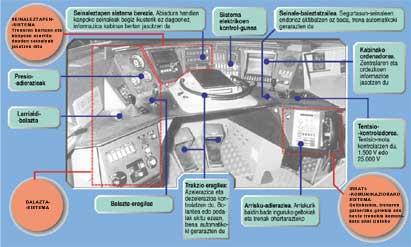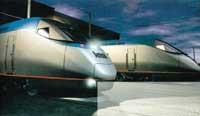Flying on the ground
“How is it said that the man who made boiling water is precious to always be calming in the hip? I have no other food if I explore the fire, smoke and the chidar well, if I have cold strength”
“The wisdom of my world has been very superficial I ask God, although I will clarify that before we did not know that he was an electrician who now fed on cold waters as he had done before.”
Flying on the ground
In Euskal Herria, the TAV only travels 20 kilometers between Baiona and Hendaia, but it is the most comfortable way for the Basques on both sides of the border to Paris. In the future it will travel Euskal Herria from Aturri to the Ebro in search of the other end of the Lberian peninsula.

The daily visitor of Hendaia is the model of the second generation of TAV, the so-called abotic Atlantic, to differentiate from the first generation that goes to Lyon. The difference is not only due to the color of the body (hence the blue and the orange here) but to the fundamental characteristic of the TAV, the speed. The old one has a speed of 270 km/h and the Atlantic TAV of 300 km/h. Logically, to get a speed difference of 30 km/h you have to change something more than the appearance of the dress. In summary, the improvements introduced are: new engines (lighter and twice more powerful), a 70% higher brake capacity (with anti-lock mechanism), pneumatic suspension, lighter cars, etc.
The TAV consists of two motor cars (the first and the last), among which, forming a homogeneous set, ten articulated cars are arranged under the intersection of two with a bogie. There is, therefore, a locomotive and two cars with rear bogies. As we know, it is called each type of two-axle carriage that supports the structure of the bogie train.
The increase in the speed of the train can be thought to be resolved with an increase in the strength of the locomotive. However, it is an error. The high speed is something more than power.
The TAV has a wide system of communication, since it is necessary to control at all times what is happening. This means computer and audiovisual equipment. In each branch there are 16 computers connected to each other that monitor all the functions of the train. The driver's room is full of control devices and all the data of errors and functions in each branch are transmitted by radio to the control tower of Paris. In the railroad, ten kilometers away, are the transmission beacons.

The TAV takes force through the catenary/pantograph system, exactly like the trams. The catenary and pantograph should be in continuous contact so that the train can catch electric energy, but the touch produces waves in the catenary, the cable. In general and until reaching 450 km/h, the speed of propagation of the wave is higher than the speed of circulation of the train and there are no problems of contact between catenary and pantograph. Above this value, the train captures the wave and loses the electrical contact between the catenary and the pantograph. This problem is avoided by pulling the cable of the catenary, being the speed of propagation of the wave again greater than that of the train. They have gone from a voltage of 2,000 decanewtons to 2,700 daN. The new limit through this stretch is around 520 km/h.

High speed also affects the railway. It needs a special strength to withstand the strength of the wheels. In 1955 a speed of 331 km/h was reached through the experimental trains in Landeta, but the railway was deteriorated, so that everything was renewed. When looking for high speeds, the railway design must also be special: heavier, more stable and more accurate. The rails weigh 60 kg/m instead of 45-50 kg/m. They consolidate more strongly on the ground and the parallelism and alignment are especially controlled. Optical instruments control differences of a few millimetres in length per kilometer. The TAV has 4,000 tons of ballasts, 1,600 sleepers and 120 tons of rails per kilometer.
Main features of the Atlantic TAV
- Two motor cars (first and last) and ten articulated cars each other.
- Length: 280 m (280 m)
- Weight charged: 490 tons tons
- Power of the engines: 14.000 C.P.
- Seats: Seats: 485 fixed and 37 foldable.
- Braking distance of 300 km/h: 3.300 m m
- Maximum speed in passenger services: 300 km/h on TAV track; 160 km/h on conventional track.
Buletina
Bidali zure helbide elektronikoa eta jaso asteroko buletina zure sarrera-ontzian











